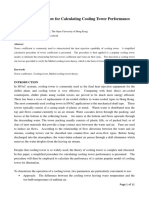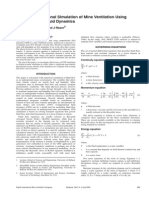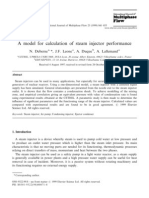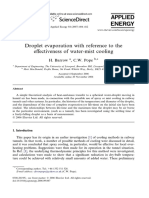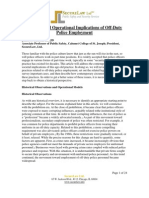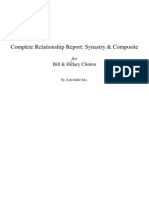Measurement and Estimation of Evaporation From Surfaces.
Measurement and Estimation of Evaporation From Surfaces.
Uploaded by
Mukudzei Gumbo-MberiCopyright:
Available Formats
Measurement and Estimation of Evaporation From Surfaces.
Measurement and Estimation of Evaporation From Surfaces.
Uploaded by
Mukudzei Gumbo-MberiOriginal Description:
Original Title
Copyright
Available Formats
Share this document
Did you find this document useful?
Is this content inappropriate?
Copyright:
Available Formats
Measurement and Estimation of Evaporation From Surfaces.
Measurement and Estimation of Evaporation From Surfaces.
Uploaded by
Mukudzei Gumbo-MberiCopyright:
Available Formats
International Journal of Computer and Communication Engineering 6 2012
Measurement and Estimation of Evaporation from Water Surfaces: Application to Dams in Arid and Semi Arid Areas in Algeria
Malika Fekih, Mohamed Saighi
AbstractMany methods exist for either measuring or estimating evaporation from free water surfaces. Evaporation pans provide one of the simplest, inexpensive, and most widely used methods of estimating evaporative losses. In this study, the rate of evaporation starting from a water surface was calculated by modeling with application to dams in wet, arid and semi arid areas in Algeria. We calculate the evaporation rate from the pan using the energy budget equation, which offers the advantage of an ease of use, but our results do not agree completely with the measurements taken by the National Agency of areas carried out using dams located in areas of different climates. For that, we develop a mathematical model to simulate evaporation. This simulation uses an energy budget on the level of a vat of measurement and a Computational Fluid Dynamics (Fluent). Our calculation of evaporation rate is compared then by the two methods and with the measures of areas in situ. KeywordsEvaporation, temperature, CFD, Dams
Energy budget, Surface water
The rate of evaporation depends on the [3]: Type of pan Type of pan environment Method of operating the pan Exchange of heat between pan and ground Solar radiation Air temperature Wind; and Temperature of the water surface. Almost universally, a simple pan factor Kpan is then introduced and where Epan is the measured evaporation from the pan [4]-[5], the water storage evaporation E is then given by:
E = E pan K pan
(1)
I. INTRODUCTION of the simplest and oldest techniques to measure evaporation from a natural surface and from a dam is made, in different countries and in particular in Algeria, is based on the measurement of the water evaporation from a pan. The basic idea in the use of evaporation pans was that these measurements can be assumed to be proportional to evaporation from an open water surfaces, such as lakes or dams.
NE
II. MEASUREMENT METHODS Evaporation pans have been used to measure evaporation for over a century. Two kinds of pans are widely used in the world. The class A pan and the sunken pan. The later is the one used in Algeria. It consists of a pan of a square cavity of dimension 0.92m0.92m0.50m, almost totally buried in the ground. It contains water surface up to the original ground surface. The Class-A pan is considered to be the standard international pan [1]-[2].
M.Fekih is with the Laboratory of Thermodynamics and Energetically Systems LTSE ,Physics Faculty, University of Science and Technology Houari Boumediene,U.S.T.H.B, Bab Ezzouar 16111, Algiers Algeria (e-mail: fekih.mali2005@ yahoo.fr). M.Saighi is with the Laboratory of Thermodynamics and Energetically Systems LTSE, Physics Faculty, University of Science and Technology Houari Boumediene,U.S.T.H.B, Bab Ezzouar 16111, Algiers Algeria Faculty of physics, U.S.T.H.B. BP 32 Bab Ezzouar, Algiers, Algeria (e-mail: saighimohamed@yahoo.fr).
b
Fig. 1 a) Measure evaporation on sunken pan b) Class A pan
305
International Journal of Computer and Communication Engineering 6 2012
III. CALCULATION METHODS We choose to calculate the evaporation rate from the pan using the energy budget equation and the computational fluid dynamics. They will be detailed as follows: A. The energy budget method The energy budget method is recognized as the basic method to determine evaporation from an open water surface. The equation of the energy budget is written as:
R n = Lv E + H + G
Where KE: is the convective mass transfer coefficient calculated from the Lewis hypothesis. h (9) KE = c cp Pvs: is the saturated vapour pressure calculated from ClapeyronClausius formula:
5204 .9 Pvs (T ) = exp 25 .5058 T and pV (Ta ) = H r Pvs (Ta ) (10)
(2)
(11)
where Rn is the net radiation on the surface. A part of it is used to vaporize water and gives rise to a latent heat flux LvE, where E is the evaporation speed per unit area and Lv the latent heat of water vaporization (2.4 106 J/Kg). The remainder is dissipated as sensible heat flux H which heats the air and as a heat flux G stored in water. Since we can neglect the term of storage compared to the other terms, we let G 0 [6]-[7] and [8]. Then the rate of evaporation becomes:
E = Rn H Lv
Replacing equations (4), (5) and (7) in equation (2), the energy budget is finally written as:
(1 ) R g + (T a 6 ) 6 T s4 h 0 (T s T a ) = Lv K E M w [Pvs (T s ) Pv (T a ) ] RT a
(12)
(3)
The resolution of equation (12) allows us to calculate the surface temperature Ts at every moment of the day according to the hourly data of the following parameters: the net radiation Rn per unit area, the air temperature Ta, the relative humidity Hr and the wind speed V. The resolution of this equation is carried out with Dichotomy method. The value of the surface temperature Ts calculated at every moment gives us access to the water flux evaporated at the surface. B. Numerical model and calculation method The domain of study is a two-dimensional model and has been constructed using the finite control volume approach on a vertical section of a 0,92m x 0,92m x 0,5m ring tank Fig. 2 (b).
with
H = hc (T s T a )
(4)
(5)
and
R n = (1 ) R g + (T a 6 ) 4 T s4
where hc is the coefficient of convective heat transfer in turbulent boundary layer on flat plate [9]:
( h c = 5 . 907 V
0 .8
0 .2 L ) c
(6)
Rg: is the global radiation which corresponds to the sum of the direct and diffuse solar radiations of short wavelength. it is written as:
A1 R g = 0 . 271 I 0 A1 sinh + 0 . 706 I 0 A1 sinh exp sinh
(7)
The temperature at the surface Ts is an important input parameter. Its calculated from the resolution of the energy budget equation at the surface (equation (1)).The latent heat flux is calculated from a Stefan equation (equation (5)) based on the Fick low [10]-[11] and [12]. Thus, we have: Lv E = Lv K E M w RT a
b
Fig. 2 a) Dimensions of the Problem H=0.5m ; h=0.20m (b)Geometry of the Pan modeled
[Pvs (Ts ) Pv (Ta ) ]
(8)
A computational grid was established using GAMBIT software and computational fluid dynamics (CFD) was then performed using FLUENT version 6.3 software. The flow is governed by the incompressible unstable equations of Navier-
306
International Journal of Computer and Communication Engineering 6 2012
Stokes and energy to determine the heat flux within the pan. We adopt the Boussinesq approximation. Computational Fluid Dynamics (CFD), based on the solution of continuity, energy, Navier-Stokes equations, k- standard model of turbulence and under the Boussinesq hypothesis, can provide the air speed, temperatures and heat flux. The continuity equation is:
u i =0 xi
(13)
Fig. 3 Comparison between measured and simulated and energy budget method evaporation from the pan for the three areas of Algeria
The momentum equation is:
u i u i 2ui 1 P * +uj = f c ij 3 j u j +v t x j xi x 2 j
(14)
The energy equation:
dTv (15) = Tv cp dt Simplified Assumptions: Near the surface, the airflow is quasi- steady. We can neglect the effects of pressure and Coriolis forces. The flow is modelled by a turbulent flow, homogeneous horizontally, with constant flux, we neglect the interaction of radiative flux and the effect of moisture on the various turbulent mechanisms. The corrections made by the introduction of the virtual temperature of the air (to take into account the presence of water vapor) and of the potential temperature (to take into account the variation of the temperature with altitude) can be neglected (for the first meters from the surface).
The form of the curves, obtained by the various formulas used for the evaporation calculation, is similar for the three studied areas. We observe a significant difference between the simulated and the measured evaporation in the hot period for the wet area. We observe concerning the arid area, a shift between measurement and simulation from June on. Theoretically, the maximum solar radiation is reached in June 21st, but really the temperature of the air reaches its maximum in July and up to fifteen of August. V. CONCLUSION Pans are a very practical tool to measure evaporation, especially in the areas where the input climatic variables are not available. But, the comprehension of the phenomenon related to it remains a difficult task. We note that the evaporation calculation, made by the two methods used (Energy budget and using CFD), gives identical results. In addition, this investigation shows: A notable difference between simulated evaporation and that measured in summer period for the wet area. We can not give a coherent explanation to this phenomenon, especially when this variation does not hold for the two other regions. We intend to continue our research in order to give a physical acceptable explanation for this variation. The influence of the lateral conduction between the adjacent soil; in the case of the sunken pans; and the walls of the pan (or between the lateral walls of a class A pan and the near air) is minor on the evaporation simulation. The flow mode, which prevails above the pan, is undoubtedly a laminar mode, which is different from the fully turbulent mode at the surface of a dam. To circumvent this problem, it is necessary to use a larger size pan so that the analogy with a barrage would be closer to reality. Many problems associated with small pans can be eliminated if the size of the pan is increased. Trials with very large pans or tanks are taking place now. With these pans, the height of the lip is small compared to the overall width of the pan, so lip errors are significantly reduced.
IV. RESULTS AND DISCUSSION We calculated the evaporation rate for June month of year 2004 for three regions of Algeria: Humid region (Kaddara Dam) Semi arid region (Foum El Gheiss Dam) Arid region (Djorf Ettorba Dam)
307
International Journal of Computer and Communication Engineering 6 2012
ACKNOWLEDGMENT Our calculations required a minimum of climatic data including: the air humidity, the wind speed and the air temperature. They were gracefully given to us by the National office of Meteorology (Office Nationale de Mtorologie: ONM). Concerning the specific characteristics of the dams, we thank the National Agency of Dams and Transfers (ANBT: Agence Nationale des Barrages et Transferts) for their assistance. REFERENCES
Craig, I.P, Mossad, R., and Hancock, N. Development of a CFD based Dam Evaporation Model. International Symposium on Environmental Health Climate Change and Sustainability. (2006). [2] Craig, I.P, Literature Review of Methods for Assessing Dam Evaporation. Draft report for the Rural Water Use Efficiency Initiative Evaporation Control Project, NCEA Draft Report, University of Southern Queensland (2004). [3] Jones Frank. E. Evaporation of water with Emphasis on Applications and Measurements, Lewis Publishers, Michigan, USA, 1992. [4] Oroud I.M, The influence of heat conduction on evaporation from sunken pans in hot, dry environment. Journal of Hydrology, Vol. 210, pp. 110 (1998). [5] Martinez. M.J.M, Alvarez Martinez V, Gonzalez-Real M.M., Baille. A. A simulation model for predicting hourly pan evaporation from meteorological data. Journal of Hydrology, Vol. 318, pp250261, 2006. [6] Fennessey. N. M, Vogel. R.M. Regional models of potential evaporation and reference evapotranspiration for the northeast USA, J Hydrology, Vol.184, pp. 337-354. [7] Saghi. M, Nouveau modle de transfert hydrique dans le systme sol- plante- atmosphre, Thse de Doctorat USTHB, Alger (2002). [8] Eichinger.W.E., Nichols. J, Prueger .J.H, Hipps. L.E., Neale .C.M.U, Cooper. D.I, and Bawazir.A. S. Lake evaporation estimation in arid environments: Final Report, IIHR - Hydroscience & Engineering, IIHR Report No. 430, University of Iowa, pp1-29, July 2003. [9] Sartori. E, Convection coefficient equations for forced air flow over flat surfaces. J Solar Energy, Vol. 80, pp. 10631071(2006). [10] Mosner. M.S. and Aulenbach .B.T, (2003). Comparison of methods used to estimate lake evaporation for a water budget of Lake Seminole, southern Georgia and northwestern Florida. Proceedings of the 2003 Georgia Water Resources (2003). Conference, held April 2324, 2003, at the University of Georgia. Kathryn J. Hatcher, editor, Institute of Ecology, the University of Georgia, Athens, Georgia, pp.1-4. [11] Lewis. J.M. The history behind the Bowen ratio, Bulletin of the American Society, Vol.76, No.12, December 1995. [12] Bowen, I.S. 1926 .The ratio of heat losses by conduction and by evaporation from any water surface. Phys. Rev. 27 779-787. [1]
308
You might also like
- ZTBL Internship Report PDFDocument71 pagesZTBL Internship Report PDFmuhammad waseem100% (8)
- Nameless and AccursedDocument166 pagesNameless and AccursedDraco Sanguinis Domini100% (13)
- Subject: It Capstone Project: University of Education Lahore, D.G.Khan CampusDocument18 pagesSubject: It Capstone Project: University of Education Lahore, D.G.Khan CampusIT LAb 2No ratings yet
- Event Management Quotation Template PDFDocument17 pagesEvent Management Quotation Template PDFVita PerdanaNo ratings yet
- Wanted - A ChaperonDocument2 pagesWanted - A Chaperonpaulinavera78% (9)
- Evaluation of Two Methods For Estimation of Evaporation From Dams Water in Arid and Semi Arid Areas in AlgeriaDocument6 pagesEvaluation of Two Methods For Estimation of Evaporation From Dams Water in Arid and Semi Arid Areas in AlgeriaInternational Journal of Application or Innovation in Engineering & ManagementNo ratings yet
- 180 PaperDocument4 pages180 PaperBenson LiuNo ratings yet
- Fluent Help Evaporation TutorialDocument5 pagesFluent Help Evaporation TutorialsidyantNo ratings yet
- Modeling of Geothermal Water Cooling SystemDocument7 pagesModeling of Geothermal Water Cooling Systemsum1else4No ratings yet
- Three-Dimensional Numerical Analysis of Wet Cooling TowerDocument8 pagesThree-Dimensional Numerical Analysis of Wet Cooling TowerDjimi DjaalebNo ratings yet
- MECH3423 Building Services Engineering II Experiment 1: Basic Water Cooling TowerDocument6 pagesMECH3423 Building Services Engineering II Experiment 1: Basic Water Cooling TowerMahleh Thabe'khuluNo ratings yet
- Evapotranspiration PDFDocument5 pagesEvapotranspiration PDFJohn Rodolfo BultronNo ratings yet
- A Comprehensive Approach To Cooling Tower DesignDocument17 pagesA Comprehensive Approach To Cooling Tower DesignMarcio NunesNo ratings yet
- SolarsDocument11 pagesSolars11751175No ratings yet
- 05 Hydrologic LossesDocument39 pages05 Hydrologic LossesMaan HinolanNo ratings yet
- Chapter Three EvaporationDocument41 pagesChapter Three EvaporationAbdizalaam ElmiNo ratings yet
- Hydro KowDocument12 pagesHydro KowEmmanuel Sto TomasNo ratings yet
- Coolingtower With Tabulation PDFDocument6 pagesCoolingtower With Tabulation PDFsankarsuper83No ratings yet
- A Simplified Procedure For Calculating C PDFDocument11 pagesA Simplified Procedure For Calculating C PDFsumayaNo ratings yet
- Chapter 3 - Evaporation - Processes - Measurements - StudentsDocument75 pagesChapter 3 - Evaporation - Processes - Measurements - StudentshmutandaNo ratings yet
- Models - Cfd.boiling WaterDocument26 pagesModels - Cfd.boiling WaterShawonChowdhuryNo ratings yet
- Mass Transfer (MT)Document11 pagesMass Transfer (MT)杨佳雯No ratings yet
- Thomas 1998Document21 pagesThomas 1998nadir adelNo ratings yet
- A.zerrouki Et El The Natural Circulation Solar Water Heater ModelDocument11 pagesA.zerrouki Et El The Natural Circulation Solar Water Heater ModelJuan-Pierre HerbothNo ratings yet
- Steam Hammer - TheoryDocument6 pagesSteam Hammer - TheoryktsnlNo ratings yet
- A Three-Dimensional Simulation of Mine Ventilation Using Computational Fluid DynamicsDocument3 pagesA Three-Dimensional Simulation of Mine Ventilation Using Computational Fluid DynamicsTariq FerozeNo ratings yet
- Free and Forced Convection Heat TransferDocument10 pagesFree and Forced Convection Heat Transferhayder alaliNo ratings yet
- Models - Cfd.boiling WaterDocument26 pagesModels - Cfd.boiling WatermadriNo ratings yet
- Advanced Energy: An International Journal (AEIJ)Document11 pagesAdvanced Energy: An International Journal (AEIJ)virginiawoolf.vw01No ratings yet
- 3-Evaporation - READY - FINAL - 2019-20 - ModifiedDocument28 pages3-Evaporation - READY - FINAL - 2019-20 - ModifiedDanNo ratings yet
- Chapter Three Water Losses: Evaporation From Water Surfaces (Lake Evaporation)Document14 pagesChapter Three Water Losses: Evaporation From Water Surfaces (Lake Evaporation)به شدار ازاد عبدالرحمن عليNo ratings yet
- Models - Cfd.boiling WaterDocument26 pagesModels - Cfd.boiling Watersjrjanakiraman6870100% (1)
- t9 Cooling TowerDocument29 pagest9 Cooling TowerIzzat FakhriNo ratings yet
- ERT 318/4 Unit Operations SEMESTER 1 (2013/2014) : Water Cooling TowerDocument18 pagesERT 318/4 Unit Operations SEMESTER 1 (2013/2014) : Water Cooling TowerNorzaifee NizamudinNo ratings yet
- Thermal Model of Solar Swimming PoolsDocument5 pagesThermal Model of Solar Swimming PoolsUmer AbbasNo ratings yet
- Dynamic Discharge Simulation of Caves in Caes System-Huntorf Case StudyDocument8 pagesDynamic Discharge Simulation of Caves in Caes System-Huntorf Case StudyDouglas GomesNo ratings yet
- Models - Heat.evaporative CoolingDocument26 pagesModels - Heat.evaporative CoolingJorge Agüero LópezNo ratings yet
- Model For Calculating Steam Ejector PerformanceDocument15 pagesModel For Calculating Steam Ejector PerformanceMuhammad KhurramNo ratings yet
- JMP20110200003 12117895 PDFDocument10 pagesJMP20110200003 12117895 PDFmmhortaNo ratings yet
- 03a EvaporationDocument39 pages03a EvaporationAgustino WaitihacheNo ratings yet
- Predict Storage Tank Heat Transfer Precisely Rev2Document16 pagesPredict Storage Tank Heat Transfer Precisely Rev2zefiloNo ratings yet
- Lawce 3Document140 pagesLawce 3habunganftwNo ratings yet
- A Critical Investigation Into The Heat and Mass Transfer Analysis of Crossflow Wet Cooling TowersDocument23 pagesA Critical Investigation Into The Heat and Mass Transfer Analysis of Crossflow Wet Cooling TowersStephen NicholsNo ratings yet
- Ability of Single-Well Injection-Withdrawal Experiments To Estimate Ground Water VelocityDocument7 pagesAbility of Single-Well Injection-Withdrawal Experiments To Estimate Ground Water Velocityiky77No ratings yet
- Reservoire DescriptionDocument22 pagesReservoire DescriptionIatan Eugen MihaiNo ratings yet
- Heat and Mass Transfer Calculation of The Intercooler With SprayiDocument6 pagesHeat and Mass Transfer Calculation of The Intercooler With SprayiBertalan Gyuszi Kristóf0% (1)
- Lec 12Document24 pagesLec 12Hermínio NhatuveNo ratings yet
- Theory Study Material AGM 504Document18 pagesTheory Study Material AGM 504SWARUP SAMANTANo ratings yet
- Investigation of A Flow Coefficient For Predicting A Natural Circulation of Water in A Built-In-Storage Solar Water HeaterDocument5 pagesInvestigation of A Flow Coefficient For Predicting A Natural Circulation of Water in A Built-In-Storage Solar Water HeaterchrissbansNo ratings yet
- GCC 0189Document7 pagesGCC 0189Aniculaesi MirceaNo ratings yet
- Effect of Sucking The Hot Fluid Film On The Performance of Flat Plate Solar Energy CollectorsDocument13 pagesEffect of Sucking The Hot Fluid Film On The Performance of Flat Plate Solar Energy CollectorsResearcherzNo ratings yet
- Cooling TowerDocument32 pagesCooling TowerPrasoon ChaturvediNo ratings yet
- Theoretical Analysis Report: Problem DefinitionDocument6 pagesTheoretical Analysis Report: Problem Definitionwtt1640No ratings yet
- Droplet Evaporation With Reference To The Effectiveness of Water Mist CoolingDocument9 pagesDroplet Evaporation With Reference To The Effectiveness of Water Mist CoolingWhidas PrihantoroNo ratings yet
- Prediction of Heat Transfer in An Axisymmetric Turbulent Jet Impinging On A Flat PlateDocument11 pagesPrediction of Heat Transfer in An Axisymmetric Turbulent Jet Impinging On A Flat PlateSylvainDMinesNo ratings yet
- Mathematical Modeling of A Closed Circulation Solar DesalinationDocument7 pagesMathematical Modeling of A Closed Circulation Solar DesalinationmdkhamisNo ratings yet
- امير PDFDocument6 pagesامير PDFMurtadha AhmedNo ratings yet
- Wet Wall AbsorptionDocument11 pagesWet Wall Absorptionhagt813No ratings yet
- Hydrological CycleDocument7 pagesHydrological CycleMiguel MarshallNo ratings yet
- Chilled Water Plant Optimization Based On Part-Load Cooling Tower PerformanceDocument22 pagesChilled Water Plant Optimization Based On Part-Load Cooling Tower PerformanceCarlos TorresNo ratings yet
- Air Entrainment - 02Document16 pagesAir Entrainment - 02ThejaswiniNo ratings yet
- 2005 OMAE 67448 - KleefsmanLootsVeldmanBuchnerBunnikFalkenberg PDFDocument12 pages2005 OMAE 67448 - KleefsmanLootsVeldmanBuchnerBunnikFalkenberg PDFaminNo ratings yet
- Beyond Global Warming: How Numerical Models Revealed the Secrets of Climate ChangeFrom EverandBeyond Global Warming: How Numerical Models Revealed the Secrets of Climate ChangeNo ratings yet
- Secrets BoxDocument7 pagesSecrets Boxdina EzzatNo ratings yet
- Science 7 2Document5 pagesScience 7 2Emmanuel Arthur DancelNo ratings yet
- A Guide To Catholic BaptismDocument2 pagesA Guide To Catholic Baptismirish x100% (1)
- Unit 2 - Assessing The Internal Environment (Revised - Sept 2013)Document28 pagesUnit 2 - Assessing The Internal Environment (Revised - Sept 2013)Cherrell LynchNo ratings yet
- Electrical Engineering Aptitude PaperDocument3 pagesElectrical Engineering Aptitude PaperAshok SainiNo ratings yet
- CP For LA SLA 2020 PandemiDocument1 pageCP For LA SLA 2020 PandemiFadil MuliawanNo ratings yet
- Process of CommunicationDocument21 pagesProcess of CommunicationGeetanjali MishraNo ratings yet
- Liability and Operational Implications of Off-Duty Police EmploymentDocument24 pagesLiability and Operational Implications of Off-Duty Police EmploymentSecurelaw, Ltd.100% (1)
- Insertion SortDocument21 pagesInsertion SortAkif VohraNo ratings yet
- Gospel Message For YouthDocument3 pagesGospel Message For YouthElizabethNo ratings yet
- Chapter 2 Strategic Management ProcessDocument52 pagesChapter 2 Strategic Management ProcessAarnesh_Karamc_1764100% (2)
- ID Komunitas Metal Underground Di Pekanbaru Studi Gaya Hidup PerkotaanDocument15 pagesID Komunitas Metal Underground Di Pekanbaru Studi Gaya Hidup PerkotaanMandoNo ratings yet
- Benifit MotiDocument4 pagesBenifit MotiFehmina syedNo ratings yet
- Plosive Consonant Pronunciation Lesson What S Your Favorite FoodDocument6 pagesPlosive Consonant Pronunciation Lesson What S Your Favorite FoodGabriela CastellinoNo ratings yet
- Synastry and Composite Report For Bill and Hillary Clinton (Astrolabe Sample)Document66 pagesSynastry and Composite Report For Bill and Hillary Clinton (Astrolabe Sample)Jeffrey KishnerNo ratings yet
- Development of Early Marriage Attitude Scale A MulDocument12 pagesDevelopment of Early Marriage Attitude Scale A MulMinahil IlyasNo ratings yet
- Bazerman CarrollDocument48 pagesBazerman CarrollNina KakesNo ratings yet
- 102 MSJC 13Document11 pages102 MSJC 13noelNo ratings yet
- Formal Charge WorksheetDocument3 pagesFormal Charge WorksheethbjvghcgNo ratings yet
- Secondary 1 (GRADE 7) SAMPLE PAPERDocument3 pagesSecondary 1 (GRADE 7) SAMPLE PAPERJoanna Marie CalibaraNo ratings yet
- Ethics, Business, and Business Ethics ReflectionDocument4 pagesEthics, Business, and Business Ethics ReflectionSandra Mae CabuenasNo ratings yet
- Civil Rights MovementDocument16 pagesCivil Rights MovementDelijaSeverKV100% (1)
- The Star of Arts Indicates One With A Mind of His Own FengShuiedDocument3 pagesThe Star of Arts Indicates One With A Mind of His Own FengShuiedWill NgoyenNo ratings yet
- CR4 - Thread - How To Calculate Flat Plate Thickness of Flat Bottom Storage Tank - PDFDocument3 pagesCR4 - Thread - How To Calculate Flat Plate Thickness of Flat Bottom Storage Tank - PDFInamullah KhanNo ratings yet
- Faculty of Law - Criminology Web SpreadsDocument9 pagesFaculty of Law - Criminology Web Spreadsspqhfx7n8qNo ratings yet



















